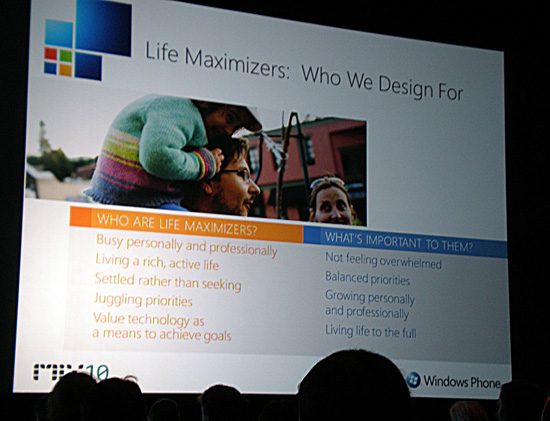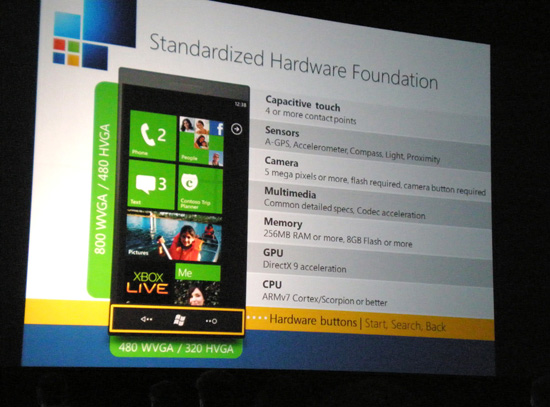Windows Phone 7 Series at MIX10
by Brian Klug on March 16, 2010 12:00 AM EST- Posted in
- Smartphones
- Mobile
Different Target Audience
I asked some of the XNA development team what they thought the biggest takeaway from the entire Phone 7 Series reboot should be, and the response was nearly unanimous: It represents a completely different target demographic focus; consumers.
Microsoft is learning from its experience with Windows Mobile by designing the phone entirely for end users and ordinary consumers; not strictly businesspeople. This target persona has been nicknamed a "Life Maximizer," and it represents the end-user the entire design, from UI to hardware, is being designed around.

Joe Belifore, VP of Phone Development, was forthcoming about both the demographic being targeted in previous Windows Mobile releases, and the tensions inherent in the development cycle for previous Windows Mobile devices. Previously, mobile operators would approach OEMs with a rough list of specifications for hardware they perceived would fill a need a gap in their lineup. The OEMs and mobile operators would work together with an existing reference design, fleshing out a device with potentially different dialers, interfaces, and end user experiences. It's a fair argument that much of the experience fragmentation that this resulted in ultimately was both Windows Mobile's biggest strength, and biggest weakness.
As we noted earlier, Phone 7 Series intends to change all of that by mandating a consistent message to end users. Part of that is also manifested in the hardware mandated now, which Microsoft has released additional details about:

Standardized Hardware Set
The specification list we heard about earlier has been fleshed out with some additional details which I've added emphasis to.
Hardware requirements are:
- Capacitive Touch
- 4 or more contact points
- Sensors
- A-GPS, Accelerometer, Compass, Light, Proximity
- Camera
- 5 megapixels or more, flash required, camera button required
- Multimedia
- Common detailed specs, Codec Acceleration
- Memory
- 256 MB RAM or more, 8 GB Flash or more
- GPU
- DirectX 9 acceleration
- CPU
- ARMv7 Cortex/Scorpion or better
- Screen
- Two Supported Displays
- 480 x 800 WVGA : Aspect Ratio 3:5
- 320 x 480 HVGA : Aspect Ratio 2:3
Note that Microsoft is now officially supporting two display resolutions; WVGA and HVGA. These are slightly different aspect ratios, with 320 x 480 HVGA being the standard 3:2 aspect ratio, and 480 x 800 being 5:3 aspect ratio. At the very least, this is something developers can be proactive about and have in mind when building software, as opposed to having the design change after the fact. Hardware launching holiday 2010 will release with 480 x 800 WVGA displays; hardware with 320 x 480 screens will launch later at some unspecified date.
I made note of this to the same XNA team mentioned earlier, who noted that scaling down applications should in theory be easier than scaling up for developers. In addition, they're looking to mitigate the aspect ratio in a number of different ways.
As for the all-important SoC choice, Microsoft is still being very tight-lipped about whether they've picked Snapdragon or one of the many other ARM-licensees' hardware designs. Reps repeatedly declined to discuss what hardware is at the core of current example hardware or whether they'll even mandate a particular chipset. In all likelihood, they'll define minimum requirements and let hardware partners meet or exceed them. Time will tell whether a particular chipset emerges as part of the requirement.
An interesting additional note not part of hardware requirements specifically, but still relevant, is that sync can be performed both tethered through USB to the computer, or over WiFi. Handsets will periodically poll computers over WiFi to see if their primary sync computer is connectible, and if so, sync. Part of the plan is to sync nightly in a manner transparent to the user and transfer photos, notes, and music so that users are never more than a day behind. I had some reservations about how well secured this method is in the long run, but we'll see more as MIX10 continues. Active Sync is dead (to much applause), and the Zune software was announced as the sync platform's successor.










24 Comments
View All Comments
nerdtalker - Tuesday, March 16, 2010 - link
I'm still doing digging on the subject, but I asked some of the XNA reps/devs about that out of curiosity.They mentioned that on virtually all the ARM SoC the choice of OpenGL versus Direct X is entirely just a matter of drivers. In fact, they reiterated a few times that they consider the OpenGL implementation a bit "academic" and slower than the Direct3D/DirectX APIs they have written.
I was puzzled about that too since most of the SoC is advertised as having some level of OpenGL compatibility. There's also some confusion about what shader model is supported; I'm told in the current release there aren't any programmable shaders, but that's not to say it can't happen.
PsychoPif - Wednesday, March 17, 2010 - link
There is no shader support at release, but it's expected later down the pipe.At launch, they added configurable shade effect to the basic ones. reports said that it was a good enough to make nice looking scenes, but don't quote me on that :)
deputc26 - Tuesday, March 16, 2010 - link
Really looking forward to some Anand-quality coverage of Android. I'm rather surprised that the yet-unlaunched Winmo7 and the floundering (though exceptional) WebOs have gotten Anand's and yet Android has not.Anand Lal Shimpi - Tuesday, March 16, 2010 - link
It's coming... :)Take care,
Anand